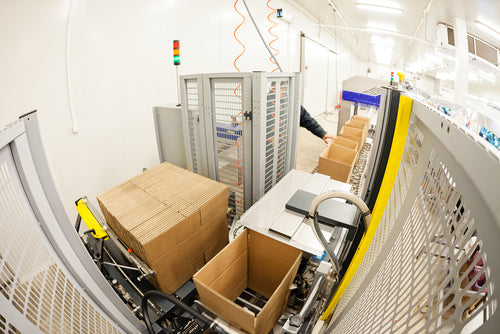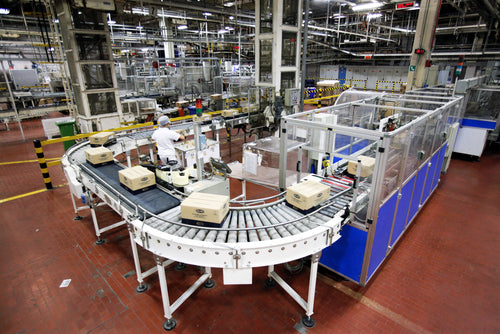The U.S. Food and Drug Administration (FDA) regulates the use of adhesives for food packaging. The regulations for substances other than adhesives discuss what should and should not come into contact with food. The FDA’s adhesive rules focus directly on the manufacturer’s responsibility to use the correct, approved adhesive for food packaging.
FDA
There are a number of country-specific legislating bodies for the use of adhesives in food packaging, but the most widely recognized is the FDA. Adhesive manufacturers must follow the formulation rules as stipulated by FDA 175.105 section, as well as section 175.300. FDA-compliant adhesives must be manufactured from pre-approved raw materials.
Regulations concerning plastic material or chemicals that come into contact with food or the food process stipulate that the substances must pass stringent food safety requirements even if they are used in packaging or the factory production environment. FDA-compliant adhesives are fairly limited in their performance and technology, so structural acrylic adhesives are forbidden.
The FDA classes food-safe adhesives as a food-contact substance “…intended for use as a component of materials used in the manufacturing, packing, packaging, transportation or holding of food that is not intended to have a technical effect in food.”
The adhesive formula manufacturer may use any substance that has been listed under FDA’s Section 175.105. The regulation places physical restraints on how the manufacturers can use adhesives in food articles and ensures the adhesives are separated from food by some form of practical barrier or layer, the adhesive doesn’t exceed the limit of GMP (Good Manufacturing Practice) and that the quantity of adhesive contacting aqueous and fatty foods doesn’t exceed trace amounts at the edge of packaging laminates.
The most important GMP requirement for packaging materials is that they are suitably pure for their intended food type, meaning they may not impart anything that can make it harmful to health, like giving the food an odor or affecting the taste. All adhesives used in flexible food packaging must be adequately cured. This ensures all components — especially the adhesive’s starting materials — are not at levels higher than was found in the testing done to establish that the product wouldn’t migrate into the food.
Ingredients
Sealing pipework on equipment such as dispensers and coffee machines is produced with a drinking-water-approved anaerobic thread sealant. Many film packing materials have a heat-activated layer that is a good value for the money, as well as being a fast way of hermetically sealing food packaging without the need to apply additional adhesive.

Options
An ideal food safe adhesive is a clean-melting, low-odor metallocene bulk hot melt by Infinity Bond. Unlike other bulk hot adhesives that have indirect food contact qualifications, all the components in this hot melt have been reviewed and are confirmed safe for direct food contact.
It offers no odor due to the metallocene base and has high-quality pot stability that will make the adhesive last longer. Food-safe adhesive is friendly on bulk equipment, eliminating a large amount of char in the nozzle and hose.
EVA bulk packaging offers a strong and fast-setting bond that works best on corrugated or cardboard stock. There is very little odor and no stringing, but it will provide great pot stability. This premium packaging hot melt can be used as a solution in 80 percent of manual and automated packaging applications. It can be applied with manual or automated bulk dispensing equipment and has heat stability and a low viscosity that make it perfect for packaging.
Infinity non-direct food contact glue sticks instantly tack and set quickly. Glue guns used in conjunction with glue sticks can come as standard or adjustable. Adjustable-temperature guns are recommended when it comes to packaging applications because they allow users to tweak the viscosity and set time. Glue guns are also recommended for use in the application of standard cardboard, corrugated packaging, cardboard, wood and end-of-line repacking.
There is also the choice of a hot melt that is metallocene based. Metallocene hot melts are different from traditional EVA (Ethylene-vinyl acetate) because they melt extremely cleanly and have almost no odor. This type of hot melt comes at a small premium, but it will be a solution for anyone having odor or bonding issues in their packaging application. This product offers a fast set time and works well with cardboard, coated stocks or corrugated items.

What Do You Use Food Safe Adhesives On?
Food-grade adhesives are required for kitchen goods, packaging applications and production line equipment. They are also found on dry food packaging, paper wrapping that encases food or to seal cartons. Food-safe adhesives that are FDA-approved are needed to bond mesh gauze on filters, sieves and strainers; seal parts on dispensing equipment like ice cream or beverage dispensers; bond ceramics, handles onto kitchen knives and coffee pots; add labels and packaging and seal production line conveyors and equipment.

